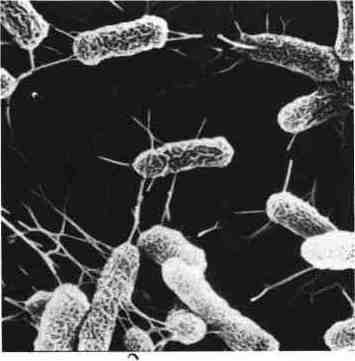
I – DEFINITION AND CLASSIFICATION:
The Enterobacteriaceae family consists of bacterial genera that are assembled because of their common bacteriological characters.
– These are Gram-negative bacilli ranging in size from January to June [im long and 0.3 to 1 microns wide;
– Mobiles by peritrichous or immobile cilia;
– If developing in aero-anaerobic and ordinary nutrient agar;
– Acidifying the glucose by fermentative route (unlikePseudomonas) often with production gas;
– Lacking oxidase (unlike Vibno and Pasteurella)
– Reducing nitrate to nitrite.
Enterobacteriaceae have a G + C% of the DNA comprised between 38 and 60 mol%.
Genetic taxonomic work based on the hybridization of DNA led to the recent award of new genera and new species, many of which have no pathogenicity defined.
Here are the types described in the Enterobacteriaceae: Buttiauxella, Cedecea, Citrobacter, Edwardsiella, Enterobacter, Erwinia, Escherichia, Ewingella, Hafnia, Klebsiella, Kluyvera, Moellerella, Koserella, Leclercia, Morganella, Obesumbactenum, Proteus, Providencia, Rahnella, Salmonella, Serratia, Shigella, Tatumella, Xenorhabdus, Yersinia, Yokenella.
Only genera and species that have a recognized medical interest will be considered further. A hundred species of Enterobactenaceae are individualized, but 23 of them account for 99% of the strains isolated in the clinic.
II – HABITAT AND PATHOGENICITY:
Among the many some Enterobacteriaceae species are found in the environment, others in plants or animals. There are those who have a phyto-pathogenic. Among the species that can be isolated in humans, some (shigell) are constantly pathogens. Other species behave as opportunistic pathogens responsible for infections in fragile patients.Their identification is an important part of the work of bacteriology laboratory.
III – CHARACTERS CROPPING:
Enterobacteriaceae grow well in broth or on agar ordinary incubated 18 hours at 37 ° C.
– Forms S (smooth) are the usual appearance at the end of the body.
Colonies are smooth, bulging, shiny, wet, they were 2-4 mm in diameter.
The broth is evenly disorder.
– Forms R (rough) is mainly observed with strains that have undergone several subcultures.
The colonies are rough, dry, with irregular contours and matt hue.
In stock, R- give lumpy.
– The mucous colonies are usual with Klebsiella Their diameter can exceed 10 mm. they have a tendency to confluence. We can also meet with other species, including Salmonella paratyphi B.
– Dwarf colonies are observed with strains deficient in some of their metabolic pathways. They are not exceptional inEscherichia coli isolated from urinary tract infections.
IV – ANTIGENIC CHARACTERS:
The identification of Enterobacteriaceae is done by the study of biochemistry. The determination of serotype can be undertaken for strains whose identification is certain.Any other approach can only lead to nonspecific cross agglutination.
– Antigens 0
These are wall antigens comprise lipo-polysaccharides (LPS), which are thermostable and resistant to alcohol or acid.
Agglutination reactions which they operate occur slowly, consist of granular clumps, difficult to separate by stirring.
The specificity is lost by 0 R strains that are autoagglutinable in distilled water.
– The H antigens
These are flagellar antigens which are therefore present in that mobile strains. Consisting of a protein, flagellin, they are thermolabile and inactivated by alcohol.
Agglutination reactions occur where they work quickly, consist of clumps flaky, easily separated by stirring.
– K antigens
These capsular antigens generally consist of a polysaccharide outer layer. Among the K antigens are antigens L, A, B E. coli and some of the Vi antigen Salmonella or Citrobacter. These antigens make the strain which has the inagglutinable by antisera 0. They are destroyed by boiling for two hours.
Adhesion or adhesins antigens, proteinaceous, in relation with the presence of pili are classified as K antigens (K88, K99).
– Antigen Kunin
This common antigen Enterobacteriaceae is hardly found in this family, and taxonomic interest.
Antisera specifically directed against each of the bacterial antigens are prepared using the method of the specific absorption of antibody Castellani.
Antibodies that are attached to the corresponding bacterial antigen form agglutinais. After centrifugation, there remains in the supernatant that antibodies that were not contacted with the antigen.


You must be logged in to post a comment.